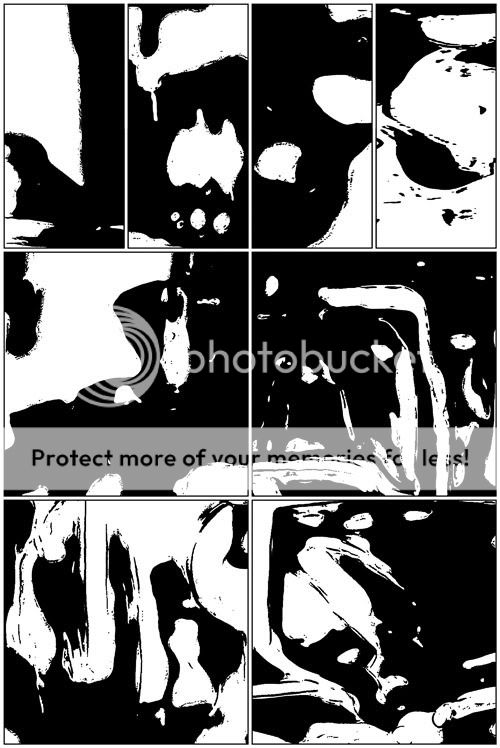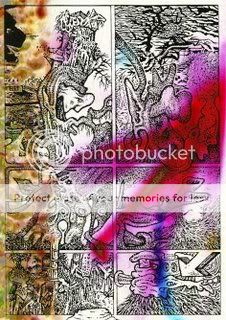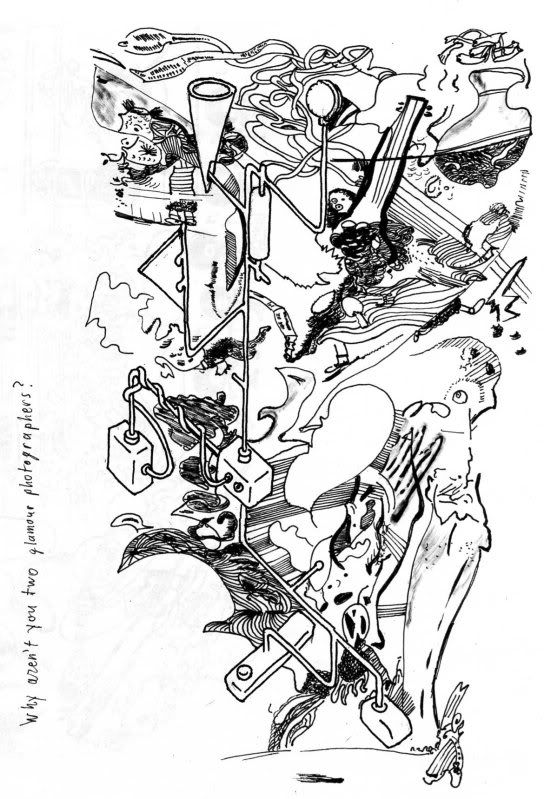In the unlikely event that you read all the comments on this blog, you’ll have seen that artist and curator Andrei Molotiu recently contacted me about my “abstract comics”. I was flattered by his interest, but also a little taken aback. Though I’ve been doing some abstractions based on comics, I really thought of them as drawings ( meant to be shown in a gallery, if I’m lucky), rather than as comics (meant to be mechanically reproduced and placed in an anthology, if I’m lucky.)
In fact, I have a lot of doubts about “abstract comics”, both as a meaningful category and as an aesthetic project. It seems to me that when comics become abstract, they really cease to be comics and become, for all effective purposes, simply abstract art. One can argue back and forth about whether “sequential art” is the best possible definition of comics, but it’s certainly true that comics relies for its existence on relationships — between image and image and/or between image and text. Abstraction is based on removing relationships and referents — you can no longer tell how you got from panel A to panel B; in fact, in many cases, you can’t even separate panel A from panel B. But when you remove the relationships, you remove the comics. You’re left with a drawing, which exists most comfortably within the visual art tradition, rather than within the tradition of comics.
There are various ways around this. You can try to do to comics what writers like John Ashberry have tried to do to language — that is, break down the connections between individual units in such a way that the juxtaposition of terms becomes evocative or mysterious in a way that approximates abstraction. (Some of Fort Thunder’s stuff works like this…or even some of R. Crumb’s trippier sixties layouts.) Or, alternately, you can adopt some of the tropes of comics (panel borders, speech bubbles, motion lines, etc.) into your drawing, so that the abstract art starts to look like a comics page.
I actually like all of these examples. Andrei’s piece below, for example, uses the panel grid to give a sense of time passing — amorphous shapes oozing and refracting in a landscape that never quites take form. It’s a nifty half-way point between abstract art and abstract film, which ties in with the Winsor McCay/Chris Ware tradition of page composition.

And I also admire the piece below by Zeke Clough, a very talented artist who I believe still hangs at my old group blog, Eaten By Ducks. Anyway, the drawing is very Gary Panter-like in using the panel borders as a stable background which emphasizes the drooling messiness of the drawing (and the sloppy ichorish colors as well.)

But though I can like individual examples, I still kind of distrust the overall project. Using abstraction as juxtaposition really works best the less abstract you get — which is compared to Wallace Stevens (who is much more willing to risk actually saying something), John Ashberry comes across as boring and pompous. And it’s awfully hard to use elements like panel borders or speech bubbles and motion lines without looking condescending or nostalgic or both. You end up, basically, attempting to validate the comics by turning them into contentless high art, or attempting to validate the high art by making it cute or fun. It’s like classical musicians playing pop hits: the smirking gets so loud it’s all you can hear.
Of course, I do abstract drawings myself, and part of this is me trying to work through what I do or don’t want to do with my own art. Anyway, if you’d like to hoist me on my own petard, you can see the drawings that Andrei was interested in here and here.



